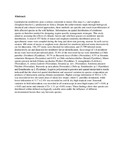An assessment of lepidopteran stemborer species distribution in relation to diversity of wild host grasses in maize and sorghum growing zines in Kenya

View/
Date
2012Author
Ong'amo, George Otieno
Type
ArticleLanguage
enMetadata
Show full item recordAbstract
Lepidopteran stemborers pose a serious constraint to maize (Zea mays L.) and sorghum (Sorghum bicolor L.) production in Africa. Despite the achievements made through biologocal, chemical and cultural control approaches, these methods are specific and result in proliferation of little affected species in the wild habitats. Information on spatial distribution of stemborer species is therefore needed for designing region specific management strategies. This study aimed at assessing the effects of climatic factors and wild host grasses on stemborer species distribution. A total of 357 fields of maize and sorghum randomly distributed across six agroclimatic zones were sampled during the long and short rain growing seasons. In each survey session, 400 stems of maize or sorghum were checked for stemborer infested stems destructively cut for dissection. 146,157 stems were checked for infestation, and 27,799 infested stems destructively cut and dissected for stemborer larvae identification. An average of 1.4 stemborer larvae were recovered per infested plant. 55.4% of the recovered larvae were identified as Chilo partellus (Swinhoe) (Pyralidae), 39.7% as Busseola fusca (Fuller) (Noctuidae), 4.5% as Sesamia calamistis Hampson (Noctuidae) and 0.8% as Chilo orichalcociliellus (Strand) Pyralidae). Minor species present include Eldana saccharina Walker (Pyralidae). S. nonagrioides (Lefebvre) (Noctuidae), S. cretica Lederer (Noctuidae), Sesamia sp. nov. (Noctuidae), Sciomesa piscator Fletcher (Noctuidae), Busseola sp near phaia (Noctuidae), Chilo sp, Ematheudes sp 1 (Pyralidae) and Ematheudes sp 2 (Pyralidae). Logistic polynomial regression and spatial interpolation results indicated that the observed spatial distribution and seasonal variation in species composition are products of interactions among climatic parameters. Higher average infestation of 30.0 ± 3.3% was recorded in low elevation areas of moist low tropics where C. partellus dominated, while lower infestation of 11.7 ± 2.4% was recorded in cool & dry high tropical zone. Seasonal variation in field infestations was recorded in all zonesexcept in most high tropics (t67 = 0.04; > 0.05) and moist mid-altitude (t72= 1.31; > 0.05) zones. These findings show that species are distributed within defined ecologically suitable areas under the influence of different environmental factors that vary between species.
URI
http://ir-library.ku.ac.ke/ir/handle/123456789/2333http://erepository.uonbi.ac.ke:8080/xmlui/handle/123456789/38148
Citation
The SB 945.L63O5Publisher
Univesity of Nairobi School of Education
Collections
- Faculty of Education (FEd) [1042]
